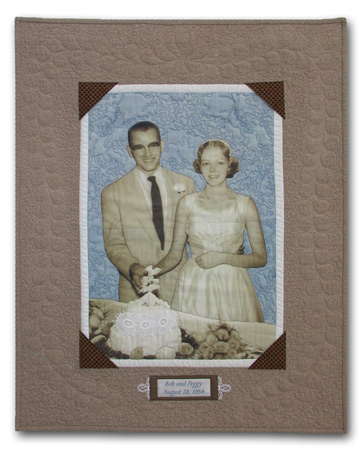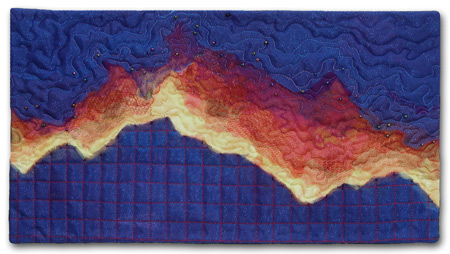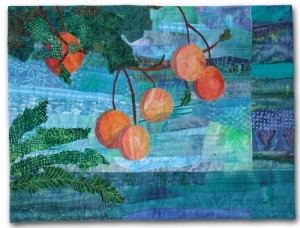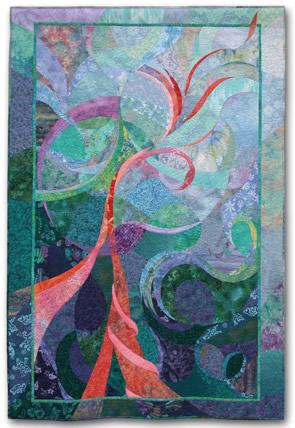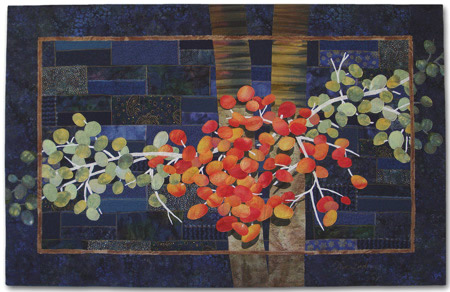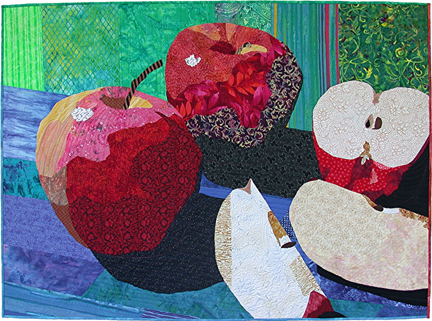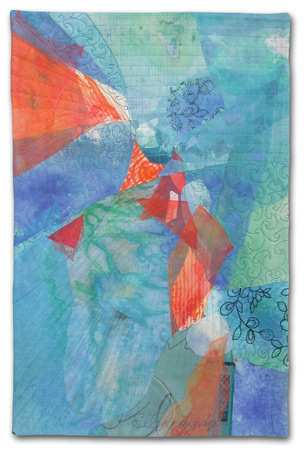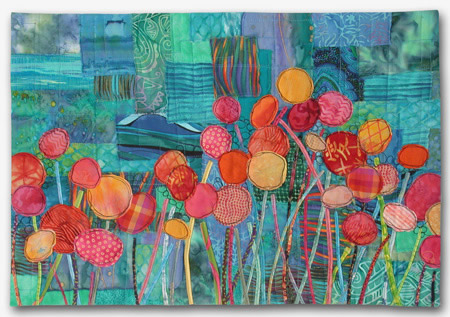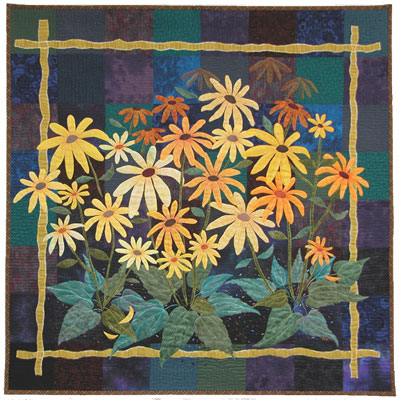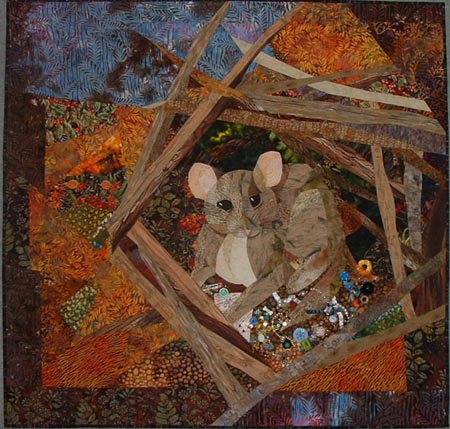Border Considerations
Borders can add a lot of beauty to art quilts, but they’re also useful in other ways. They can help draw attention to the quilt interior, add balance, help with technical challenges, and more. Still, not every quilt needs a border. In this article, I’ll share my thoughts on when to add a border, as well as some ideas for designing effective ones.
The most obvious aspect of a border is that it increases the overall size of the quilt. This is often important for small quilts. The addition of a border gives these quilts more presence, which attracts more attention. Happy Anniversary clearly benefits from having a border. Imagine how plain it would be without it!
However, not all small quilts need a border. An example is Fire at Night. This tiny quilt makes a big impact. The high contrast imagery fills the space well and the dark colors add to its sense of presence.
 A border emphasizes the imagery that’s contained within it. This is one of the primary benefits of a border, regardless of the size of the quilt. Another example can be seen in Misty Morn.
A border emphasizes the imagery that’s contained within it. This is one of the primary benefits of a border, regardless of the size of the quilt. Another example can be seen in Misty Morn.
Misty Morn is shown both with and without its border. Can you see how the border draws your attention to the interior portion? It’ s almost like circling a paragraph on a page of text.
In this case, the dark border is serving an additional function: it’s creating a contrast between the image and the light background. Since most interior walls are light, quilts with lots of light colors will often benefit from having a darker border added. (Of course, the border color and value must relate to the rest of the quilt.)
Have you ever made a quilt with an usual shape? If so, you know that it can be quite challenging to finish the outside edge. One way to address this is to add a border, like I’ve done with Cosmo Boogie. I wanted to preserve the irregular edge of the center portion. I could have finished the quilt with that shape, but adding a border was a much easier option. (Note: since the border was white, I added a black binding to create contrast with potentially light walls.)
In Crevice Bloom adding a border also helped to preserve the irregular edges of my composition. That wasn’t the primary reason for the border, however, since it’s an integral part of the design. Borders can often be major players in the overall design. They can also be used to solve certain design dilemmas.
Partial borders can be used to shift the balance or the focal point of a quilt. In Lakeside Citrus the original composition was very left-heavy. Adding a weighty border, on the right and bottom only, took care of the problem.
The location of the focal point was an issue for Ti Plants A-Glow-Glow. Initially, the focal point (left plant) seemed too far left. Enlarging the quilt with a border on the left only shifted the focal point into a more pleasing position. This new border also allowed the irregular leaf shapes to spill over the original edge, and the dark color helped to set off the bright leaves.
A partial border can also be used to add color in a particular area. This was the case with Cosmo Duet.
When considering the design of a quilt border, I believe that it MUST relate to the interior portion. This can be accomplished with color, imagery, technique, and quilting.
In no case should the border attract more attention than the interior. This can happen if the border fabric has an especially high contrast, or very bright colors. Sometimes a quilter identifies a “perfect” fabric for the border. However, that fabric might actually overpower the rest of the quilt. For instance, suppose the quilt at right had a border made from a lively high contrast lime green and fuscia print? Although such a fabric might seem like a perfect match for the floral portion, it would actually distract from it. Care should be taken to avoid this.
Color is probably the strongest connection between a quilt image and its border. Look back at some of my examples to see how I’ve used it.
Selecting a border color for Crevice Bloom was quite challenging. At the time, there was no black in the interior portion, so I was reluctant to add a black border. However, other dark fabrics didn’t work, so I looked for other ways to relate the black border and the interior. I found two. First, I added little bits of black in the floral areas, with both “fabric” and thread. (Actually, the flowers in this quilt are made from paper.) Next, I designed the quilting to continue the interior lines into the border. (See detail.)
In Misty Morn, quilting was again used to unite the border and the interior. A contrasting thread made it more visible.
It’s generally a good idea to construct the border using the same technique(s) as the interior. Hopes and Daydreams was created with a technique similar to machine applique, and this was continued with the border. In addition, some of the major seam lines were visually extended into the border.
REcall Unraveled is about dementia, as represented by the color shift and the skewing of the blocks. This visual imagery was repeated in the border, with both angled seam lines and with colors. The black from the border was also used in the interior portion, to help unite the two parts.
Looking at Cosmo Boogie again: it was constructed with a raw edge collage technique. Therefore, the border was done in the same fashion, with many pieces of white printed fabric.
One of the best ways to make the border and center portion act as one is to carry the image or pattern into the border. You’ve seen touches of this throughout this article. However, it can be done even more deliberately, as shown in the next two quilts. The berries of Ripening were continued into the border, but with much darker fabrics. The darker color acts as a frame, while the imagery continues the idea of the main part.
In Autumn Breeze, the interior portion literally continues into the border. The darker border was created by adding black tulle over the edges of the original image.
The width of your border should be enough to frame and support the main portion, without overpowering it. There’s no exact formula for that. I generally make the border wider than I think it needs to be. Then, I trim it until I’m happy with the proportions.
The widest border I’ve ever used is the left one seen in Autumn Breeze. It’s 7 1/4″ wide, and the entire quilt is 48″ wide. However, this is a much wider border than usual. I like it here, but I think you can see that a border this wide on all four sides would be too much. I find that some experimentation is required to arrive at the correct width.
It can sometimes be difficult to visualize what a border might look like. I strongly recommend taking the time to sketch and/or photograph, in order to get an image that accurately represents your border idea. I used to work with a hard copy photo of the main quilt, and create a variety of potential border frames, with colored pencils. I auditioned the options with these frames, in order to make my decision.
Now, I do something similar at my computer, with photo editing software. However, I always make my final decisions standing at the design wall, with the fabrics in front of me. Ti-Plants-A-Glow-Glow is a case in point. After photo manipulating, I decided on a dark green partial border for it. However, when I auditioned my actual fabrics, I didn’t care for them. After some trial and error, I decided on black fabrics, instead.
A digital camera is very useful for auditioning design options (for both borders and interiors.) Photographing several options and then viewing them on the camera’s screen is a great way to visually “step away” from the quilt, and to properly consider your choices.
Certainly, many quilts can stand on their own without borders. These quilts often have dark or strong colors, and may also be medium to large. They might be either representational or abstract. Here are a few of my quilts which I think work well without borders. I’ve included the dimensions, as a reference.
Of course, it wouldn’t hurt the above quilts to have a border added. Take a minute to study them. What border options might you consider for these four? Any partial borders? Darker ones? Or ones with the images continuing into the border in some way? If in doubt as to whether a border is needed, I recommend adding one. I’ve never seen a quilt that made me think, “That quilt would look better without a border.” However, I’ve sometimes had the opposite thought. So, I say “If in doubt, bring the fabric out!”
Thus far, I’ve told you how I personally handle borders. Other art quilters tackle them in entirely different ways. Unlike me, Ann Fahl starts with her border, and then creates the design that goes inside it. She pieces the entire background, adds an inner border, and begins composing. Often, her design reaches into the outer border. Ann likes working this way, because the proportions are in place from the beginning. Her quilt, A Brighter Day, demonstrates her results.
Ruth Powers considers her borders to be an integral part of the design. She plans them from the start, but fine tunes her ideas, after the main portion has taken shape. Ruth often uses a variety of fabrics, angles, and dimensions, all in one border. Like me, she uses them to handle design issues, adding color and visual weight where needed. Packrat Palace is an example.
It’s clear that borders can greatly enhance many quilts. Just remember to make sure they compliment the overall designs, rather than fight them.
Add a border to:
– Increase a quilt’s size.
– Increase the quilt’s “presence”.
– Emphasize the main composition.
– Add a darker edge to a light quilt. (In order to create contrast with the wall color.)
– More easily handle unusual shapes.
– Complete a design.
– Correct a design issue.
Be sure:
– The border relates to the main part of the quilt.
– To repeat colors, materials, and/or techniques throughout.
Avoid a border if:
– It will interfere with the main portion of the quilt.
– It will attract more attention than the primary imagery.
Resources:
Ann Fahl’s website
Ruth Power’s website
Ruth Power’s blog – (Ruth discusses border options in her 12-13-08 entry.)
Thanks to Ann Fahl and Ruth Powers for agreeing to have their quilts included as part of this article.
If you found this information useful, you may be interested in my other free articles, online classes, and e-books. Full directory

